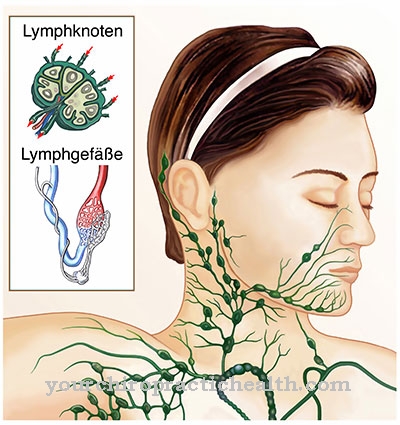At the Alström syndrome it is a genetic disease that manifests itself early in childhood. It affects the entire organ system and is associated with a low life expectancy.
What is Alström Syndrome?

Alström syndrome is an extremely rare hereditary disease that affects only a few hundred children and adults worldwide. The syndrome is inherited in an autosomal recessive manner and belongs to the group of ciliopathies. It is characterized by a large number of symptoms that affect a wide variety of organ systems and become more severe and complex with age.
The early development of photophobia and nystagmus is classic. As a rule, the progressive visual disturbance leads to complete blindness before puberty. In addition to disorders of the metabolism and endocrine system, the kidneys, liver and heart are also affected by the disease. The patient's cognitive abilities are not restricted. The syndrome was named after the Swedish doctor Carl Henry Alström, who first described the disease in 1959.
causes
Alström syndrome is passed on to the offspring via an autosomal recessive inheritance. Both parents carry a mutation of the ALMS1 gene on chromosome 2p31, which is not expressed in its heterozygous form. Only when the genetic defect is present in the genome in a homozygous form does the classic clinical picture develop.
The ALMS1 gene codes for a large protein that can be detected in the centrosome of almost all body cells and is related to the function of the cilia or the function of the cells carrying the cilia. The Alström syndrome thus belongs to the group of ciliopathies. Due to the numerous and varied functions of the cilia, the exact origin of the disease has not yet been clarified. This is still a central topic for many research groups.
You can find your medication here
➔ Medicines for painSymptoms, ailments & signs
Most of the symptoms of Alström syndrome appear in early childhood and get worse with age. The affected children usually develop photophobia and nystagmus shortly after birth. Eyesight deteriorates over the course of childhood, until children usually go completely blind by the age of twelve.
In addition to visual impairment, there is also hearing impairment during childhood. Heart problems such as dilated cardiomyopathy (a disease of the heart muscle) or sudden heart failure often occur during childhood, but can also only manifest themselves in adolescence or adulthood. The children are often overweight, they suffer from insulin resistance or type 2 diabetes and have high blood lipid levels.
Other symptoms are varied, ranging from infertility and thyroid diseases to typical facial features, thin hair or a darkening of the skin. It is not uncommon for the children to have short stature or a curvature of the spine.
Diagnosis & course
Due to the large number of symptoms that only manifest themselves as the disease progresses, the diagnosis of the syndrome is rare. Often it is only in adolescence or adulthood that the complex symptoms can be interpreted as Alström syndrome based on their constellation. If the suspicion of this disease manifests itself, the diagnosis can be confirmed by molecular genetics.
Often, however, a genetic test is not performed due to the low sensitivity. Changes in the eye make a significant contribution to the diagnosis. In the course of the disease, all patients develop nystagmus and photophobia very early on, which lead to non-inflammatory retinal disease and finally to complete blindness before reaching adolescence.
Heart failure due to a heart muscle disease can often be diagnosed even before the eye symptoms appear. The risk of heart failure therefore already exists in early childhood and persists into adulthood. Obesity occurs early on; after puberty, children usually suffer from insulin resistance and even type 2 diabetes.
Hearing loss from the age of 10 is also classic. The advancing liver and kidney damage leads to kidney failure, especially in the second to fourth decade of life.
Complications
Alström syndrome is characterized by a multitude of disorders and symptoms, the course of which becomes more and more complex as the patient ages. A reliable prognosis for the course of the disease is made even more difficult, since it is a very rare hereditary disease that affects only a few hundred patients in childhood and adulthood worldwide. The symptoms and the associated health problems appear in early childhood and worsen in the following years of life.
Light sensitivity and uncontrolled eye tremors are characteristic. The eyesight of the patient deteriorates until the age of 12 to the point that they become blind. Heart problems and heart failure mostly occur in childhood, but can also only become noticeable in adolescence or adulthood. The children often suffer from obesity, insulin resistance and type 2 diabetes.
The other disorders are diverse and range from thyroid diseases and infertility to thin hair, characteristic facial features and darkly discolored skin. From the age of 10, children lose their hearing.A crooked spine is typical of Alström syndrome. Kidney failure often occurs in the second to fourth decades of life.
In many cases, the diagnosis is delayed because the complex symptoms and disorders are often misunderstood due to the low sensitivity to this rarely occurring ciliopathy. Because of the multiple organ diseases, life expectancy is low, even with appropriate treatments and individual therapies, because very few patients reach the age of 40.
When should you go to the doctor?
As a rule, Alström syndrome is associated with a sharp reduction in the patient's life expectancy. Treatment by a doctor can therefore only alleviate the symptoms, but not completely cure them. A doctor should be consulted if the child develops significant visual disturbances at a young age that are still progressive. It is not uncommon for this to result in complete blindness. Likewise, any existing heart problems must be treated properly to prevent sudden cardiac death.
A doctor can also be consulted if the patient's resilience suddenly drops sharply for no particular reason. Furthermore, the syndrome often leads to psychological complaints, which can occur not only in the patients themselves, but also in the parents and relatives. Here, too, treatment by a psychologist is necessary to avoid depression and further upsets. In most cases, life expectancy is reduced to around 40 years due to Alström syndrome.
Doctors & therapists in your area
Treatment & Therapy
Since Alström syndrome is a genetically determined hereditary disease, the pathogenesis of which has not been clearly understood, treatment can only be symptomatic. Care of the patient in a specialized center is essential, because with an appropriate therapeutic offer and a preventive lifestyle, many symptoms can be alleviated or even avoided.
The heart should be examined regularly by means of heart echocardiography to check the functionality of the heart muscle. With blood tests, blood pressure measurements and weight reduction, the development of insulin resistance or type 2 diabetes can be counteracted at an early stage, or medication can be intervened in good time. Early blindness can be delayed by wearing special filter glasses and mobility exercises.
Learning Braille at an early stage also increases the patient's quality of life. Medicines for the treatment of heart, thyroid, liver and kidney disorders can be administered provided that thorough examinations are carried out. Organ transplants can be carried out if necessary, but are to be viewed critically due to the multi-organ disease and the prognosis of the disease.
Despite therapeutic measures that alleviate the course of the disease and improve the patient's quality of life, few patients have a life expectancy of more than 40 years.
Outlook & forecast
In most cases, the life expectancy of the patient is significantly reduced due to Alström syndrome. Since the syndrome occurs in childhood, it can also have a negative psychological impact on the patient's parents and relatives. These can suffer from depression and other psychological complaints.
The patients themselves mainly suffer from visual and hearing problems. In the worst case, this can lead to complete blindness of the patient. Furthermore, those affected also suffer from heart problems, which can lead to sudden cardiac death. The children are also overweight and suffer from thyroid disorders.
Often the Alström syndrome also leads to a short stature and a crooked spine. This complaint has an impact on the posture and movement of the person concerned.
Most of the time, the life expectancy of the patient is reduced to about 40 years due to Alström syndrome. A causal therapy is not possible, so that only the symptoms can be limited. As a rule, the person concerned is therefore dependent on regular examinations. Diabetes must also be recognized and treated at an early stage.
You can find your medication here
➔ Medicines for painprevention
Alström syndrome cannot be prevented due to its genetic cause. Still, a decent lifestyle can alleviate or prevent many symptoms. Light sports such as swimming, cycling or running are recommended.
If a mutation is already known within the family, genetic counseling should be sought, especially if you want to have children. A prenatal diagnosis may be possible.
Aftercare
Since Alström syndrome is a genetic disease that cannot be treated causally, but only symptomatically, there are usually no special follow-up options available to those affected. The life expectancy of the patient is also considerably restricted and reduced by Alström syndrome, so that most patients die at a young age.
In the case of Alström syndrome, the parents and relatives of the patient in particular are therefore dependent on psychological treatment in order to avoid further complications and depressive moods. Contact with other sufferers of the syndrome can also prove to be positive and useful, as this can lead to an exchange of information.
Those affected depend on permanent treatment and many regular examinations to alleviate the symptoms. Mobility can also be increased through various exercises, although these exercises can often also be performed in your own home. In the case of depression in the patient himself, discussions with parents, family or friends are very helpful. In severe cases, patients with Alström's syndrome need external help in their everyday life.
You can do that yourself
Alström syndrome is a progressively progressive disease that is always associated with serious complications for those affected. Therefore, the most important self-help measure is early therapy. Parents of affected children are best to speak to their general practitioner so that contact can be made with a suitable specialist.
In addition, the individual symptoms must be treated. The increasing blindness, which usually reaches its peak between the ages of ten and twelve, has to be compensated for by glasses and other aids, later by organizing a guide dog or similar assistance measures.
Hearing complaints also require comprehensive treatment, which must be regularly adapted to the progression of the disease. If psychological complaints arise as part of Alström's syndrome, such as depressive moods, anxiety attacks or inferiority complexes, further therapeutic measures are available.
The disease can be more easily accepted if there is contact with other people who suffer from the same symptoms. The patient needs different operations. Before and after these interventions, the doctor's instructions must be complied with. Optimally supervised treatment improves the chances of a relatively symptom-free life considerably.
























.jpg)



